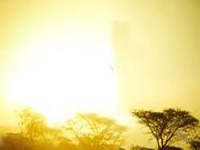Ozone and UV bulletin
The stratosphere ozone layer is slowly recovering and the recovery will be complete in most parts of the atmosphere in the coming decades, according to the latest bulletin by the World Meteorological Organization
The stratosphere ozone layer is slowly recovering and the recovery will be complete in most parts of the atmosphere in the coming decades, according to the latest bulletin by the World Meteorological Organization
<p>We present the measurements of cloud-base height variations over ARIES, Nainital (79.45°E, 29.37°N, 1958 m amsl) obtained from Vaisala Ceilometer, during the nearly year-long Ganges Valley Aerosol
The sun can erupt with flares more energetic than 30 billion times the yield of all nuclear weapons ever detonated. The energetic particles released by solar flares tunnel a path through our inner solar
<p>The importance of light-absorbing organic aerosols, often called brown carbon (BrC), has become evident in recent years. However, there have been relatively few measurement-based estimates for the direct
Atmospheric aerosols are of significant environmental importance, due to their effects on air quality, as well as their ability to alter the planet’s radiative balance. Recent studies characterizing the
<p>Global dimming refers to the decrease in surface solar radiation (SSR) observed from the 1960s to the 1980s at different measurement sites all around the world. It is under debate whether anthropogenic

The warmth of winter months has increased significantly over the past 100 years. Data of the India Meteorological Department (IMD) for the past 114 years revealed that the increase in temperature had
<p>Solar dimming and wind stilling (slowdown) are two outstanding climate changes occurred in China over the last four decades. The wind stilling may have suppressed the dispersion of aerosols and amplified
Aerosol particles can directly alter the radiation balance by scattering and absorbing incident solar radiation, thus decreasing the amount of light reaching the surface and increasing the fraction of
<p>ARIES, acronym for Aryabhatta Research Institute of Observational Sciences, located in the Central Gangetic Himalayan (CGH) region is emerging as one of the unique sites for climate change studies.
<p>Substantial changes in anthropogenic aerosols and precursor gas emissions have occurred over recent decades due to the implementation of air pollution control legislation and economic growth. The response